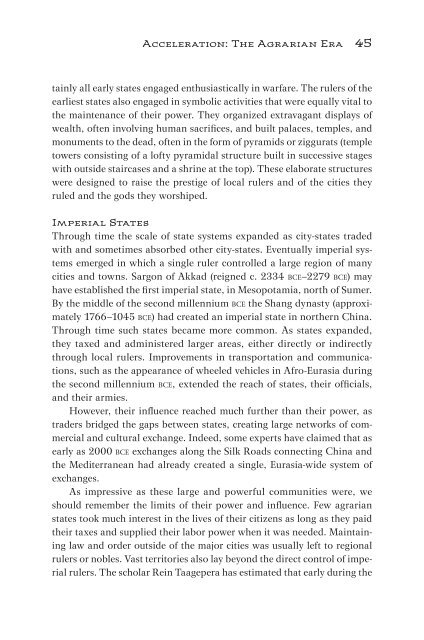This Fleeting World
This Fleeting World
This Fleeting World
You also want an ePaper? Increase the reach of your titles
YUMPU automatically turns print PDFs into web optimized ePapers that Google loves.
Acceleration: The Agrarian Era 45<br />
tainly all early states engaged enthusiastically in warfare. The rulers of the<br />
earliest states also engaged in symbolic activities that were equally vital to<br />
the maintenance of their power. They organized extravagant displays of<br />
wealth, often involving human sacrifices, and built palaces, temples, and<br />
monuments to the dead, often in the form of pyramids or ziggurats (temple<br />
towers consisting of a lofty pyramidal structure built in successive stages<br />
with outside staircases and a shrine at the top). These elaborate structures<br />
were designed to raise the prestige of local rulers and of the cities they<br />
ruled and the gods they worshiped.<br />
Imperial States<br />
Through time the scale of state systems expanded as city-states traded<br />
with and sometimes absorbed other city-states. Eventually imperial systems<br />
emerged in which a single ruler controlled a large region of many<br />
cities and towns. Sargon of Akkad (reigned c. 2334 bce–2279 bce) may<br />
have established the first imperial state, in Mesopotamia, north of Sumer.<br />
By the middle of the second millennium bce the Shang dynasty (approximately<br />
1766–1045 bce) had created an imperial state in northern China.<br />
Through time such states became more common. As states expanded,<br />
they taxed and administered larger areas, either directly or indirectly<br />
through local rulers. Improvements in transportation and communications,<br />
such as the appearance of wheeled vehicles in Afro-Eurasia during<br />
the second millennium bce, extended the reach of states, their officials,<br />
and their armies.<br />
However, their influence reached much further than their power, as<br />
traders bridged the gaps between states, creating large networks of commercial<br />
and cultural exchange. Indeed, some experts have claimed that as<br />
early as 2000 bce exchanges along the Silk Roads connecting China and<br />
the Mediterranean had already created a single, Eurasia-wide system of<br />
exchanges.<br />
As impressive as these large and powerful communities were, we<br />
should remember the limits of their power and influence. Few agrarian<br />
states took much interest in the lives of their citizens as long as they paid<br />
their taxes and supplied their labor power when it was needed. Maintaining<br />
law and order outside of the major cities was usually left to regional<br />
rulers or nobles. Vast territories also lay beyond the direct control of imperial<br />
rulers. The scholar Rein Taagepera has estimated that early during the


